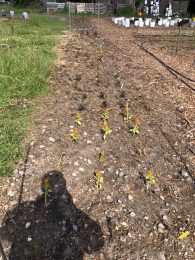
The vegetable plants are flying off the shelves at garden centers everywhere! It is great and fun to grow your own vegetables! Keeping up with a garden is another matter all in itself! The following is a list of good gardening practices to make your garden even better.
Create a “healthy” soil. In the rush to plant, this important step is often overlooked, yet it can make the difference between a productive and a so-so garden. Many insects are attracted to stressed plants. Poorly growing plants also recover more slowly from insect and/or mite injury. Conduct a soil test and follow the recommendations to supply appropriate nutrients as needed. Adding extra fertilizer won’t create healthy soil, because excess nitrogen or phosphorus can promote insect and disease problems and can lead to run-off issues. Add organic matter to the soil each year in the form of soil amendments or mulch.
Choose pest-resistant or tolerant varieties. Nursery and garden catalogs often identify such varieties. Additional information is available in the Extension publication Recommended Vegetable Varieties for Kansas, L-41.
Start with quality seeds and healthy plants. Purchase stocky, dark green transplants, and buy certified virus free seed potatoes.
Eliminate competition. Remove weeds because they compete for nutrients and water. Keep plants growing vigorously. Rapidly growing vegetables can tolerate or outgrow insect, mite and disease damage, but quickly use up available nutrients. Applying fertilizer and water at critical times during maximum plant growth is essential for producing pest- and disease-resistant plants.

Keep it clean. Remove infected plants during the season to prevent spread within the garden, and remove plant debris after harvest to avoid harboring insects, mites and diseases. Remove weeds, which may serve as a reservoir for pests. Dispose of diseased plants, fruits, and vegetables. Composting is seldom thorough enough to eliminate disease fungi and bacteria.
Rotate crops. Planting the same crop in the same place year after year invites losses due to soil borne diseases and overwintering insect pests. Follow a crop rotation of at least 3 years for the four major vegetable plant families—solanum (tomato, potato, pepper, and eggplant);
cucurbit (melons, squash, and cucumbers); cruciferous (broccoli, cauliflower, cabbage, and Brussels sprouts); and allium (onion, garlic, and leeks).
Choose a sunny location away from large trees. Eight to 10 hours of direct sunlight a day are necessary for proper growth, flowering, and fruiting of most vegetable crops. Sunlight also helps to dry foliage and reduce infection by many fungal and bacterial diseases.
Water properly. Plants receiving too much or not enough water will be less vigorous and more susceptible to insect and mite pests and diseases. Consider using a form of drip irrigation, which will keep foliage dry and prevent foliar diseases while at the same time using water more efficiently. If using a hose, direct the water towards the ground and avoid wetting the foliage.
Use mulch. Mulch helps control weeds and reduces moisture evaporation from the soil surface. Much also helps prevent rot caused when fruit is in contact with bare soil. When tilled under, organic mulches become valuable soil amendments.
Provide good air circulation. Overcrowding plants can result in weak growth and an increase in foliar diseases. Stakes, cages, trellises, and pruning all help to increase air circulation.
Plant at the proper time. Seeds planted too early are more susceptible to rot. Delay planting until the soil has warmed to allow rapid germination of seeds and growth of young plants.
Grow crops that have few pest problems. Plants that have few insect, mite and disease problems include loose-leaf lettuce, rhubarb, Swiss chard, garlic, cos lettuce, leeks, parsley, sweet potatoes, okra, beets, snap peas, parsnips, carrots, onions, and kale.
Inspect the entire garden at least weekly. Check the undersides of plant leaves. Detect symptoms when they first develop so that pest problems can be more easily controlled.
Use chemical pesticides as a last resort, carefully and judiciously. Several general-use insect pest and disease control measures are available that provide effective control with minimal environmental disturbance. Always read the label carefully and follow use directions.
If you use pesticides, apply them properly. Thorough coverage of all plant parts is required. (Apply liquids to the point of run-off.) The use of a fine spray mist directed to all plant surfaces usually is the most effective way to ensure proper pesticide action while using or wasting as little material as possible.
Be realistic in your expectations. Accept the fact that there may be some damage from pests and even an occasional crop failure.
